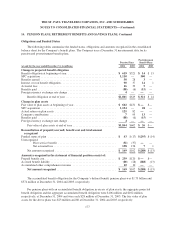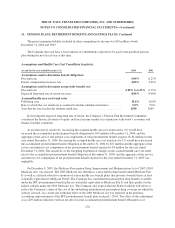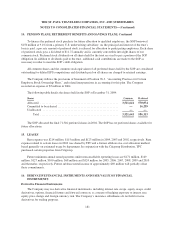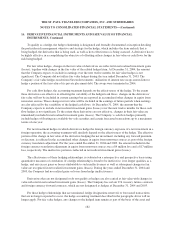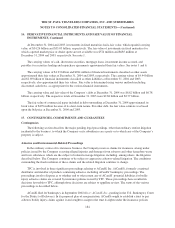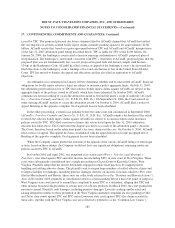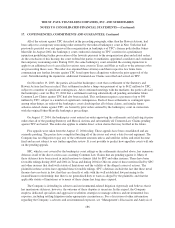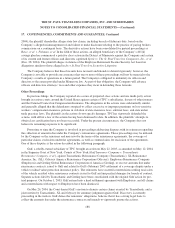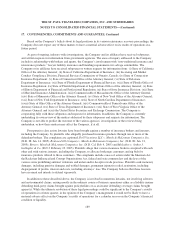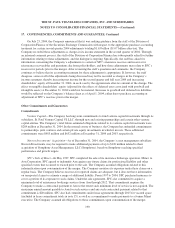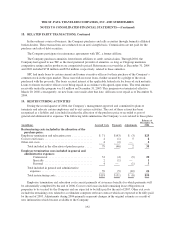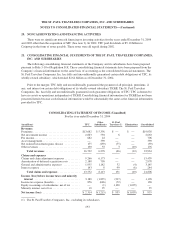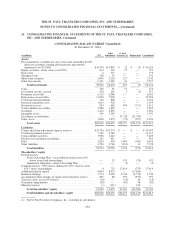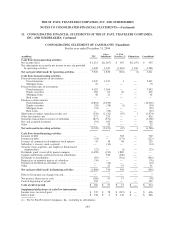Travelers 2004 Annual Report Download - page 198
Download and view the complete annual report
Please find page 198 of the 2004 Travelers annual report below. You can navigate through the pages in the report by either clicking on the pages listed below, or by using the keyword search tool below to find specific information within the annual report.THE ST. PAUL TRAVELERS COMPANIES, INC. AND SUBSIDIARIES
NOTES TO CONSOLIDATED FINANCIAL STATEMENTS—(Continued)
17. CONTINGENCIES, COMMITMENTS AND GUARANTEES, Continued
All of the actions against TPC described in the preceding paragraph, other than the Hawaii Actions, had
been subject to a temporary restraining order entered by the federal bankruptcy court in New York that had
previously presided over and approved the reorganization in bankruptcy of TPC’s former policyholder Johns-
Manville. In August 2002, the bankruptcy court conducted a hearing on TPC’s motion for a preliminary
injunction prohibiting further prosecution of the lawsuits pursuant to the reorganization plan and related orders.
At the conclusion of this hearing, the court ordered the parties to mediation, appointed a mediator and continued
the temporary restraining order. During 2003, the same bankruptcy court extended the existing injunction to
apply to an additional set of cases filed in various state courts in Texas and Ohio as well as to the attorneys who
are prosecuting these cases. The order also enjoined these attorneys and their respective law firms from
commencing any further lawsuits against TPC based upon these allegations without the prior approval of the
court. Notwithstanding the injunction, additional Common Law Claims were filed and served on TPC.
On November 19, 2003, the parties advised the bankruptcy court that a settlement of the Statutory and
Hawaii Actions had been reached. This settlement includes a lump sum payment of up to $412 million by TPC,
subject to a number of significant contingencies. After continued meetings with the mediator, the parties advised
the bankruptcy court on May 25, 2004 that a settlement resolving substantially all pending and similar future
Common Law Claims against TPC had also been reached. This settlement requires a payment of up to $90
million by TPC, subject to a number of significant contingencies. Each of these settlements is contingent upon,
among other things, an order of the bankruptcy court clarifying that all of these claims, and similar future
asbestos-related claims against TPC, are barred by prior orders entered by the bankruptcy court in connection
with the original Johns-Manville bankruptcy proceedings.
On August 17, 2004, the bankruptcy court entered an order approving the settlements and clarifying its prior
orders that all of the pending Statutory and Hawaii Actions and substantially all Common Law Claims pending
against TPC are barred. The order also applies to similar direct action claims that may be filed in the future.
Five appeals were taken from the August 17, 2004 ruling. These appeals have been consolidated and are
currently pending. The parties have completed briefing all of the issues and await a date for oral argument. The
Company has no obligation to pay any of the settlement amounts unless and until the orders and relief become
final and are not subject to any further appellate review. It is not possible to predict how appellate courts will rule
on the pending appeals.
SPC, which is not covered by the bankruptcy court rulings or the settlements described above, has numerous
defenses in all of the direct action cases asserting Common Law Claims that are pending against it. Many of
these defenses have been raised in initial motions to dismiss filed by SPC and other insurers. There have been
favorable rulings during 2003 and 2004 in Texas and during 2004 in Ohio on some of these motions filed by SPC
and other insurers that dealt with statute of limitations and the validity of the alleged causes of actions. The
plaintiffs in these actions have appealed these favorable rulings. SPC’s defenses include the fact that these novel
theories have no basis in law; that they are directly at odds with the well established law pertaining to the
insured/insurer relationship; that there is no generalized duty to warn as alleged by the plaintiffs; and that the
applicable statute of limitations as to many of these claims has long since expired.
The Company is defending its asbestos and environmental-related litigation vigorously and believes that it
has meritorious defenses; however, the outcome of these disputes is uncertain. In this regard, the Company
employs dedicated specialists and aggressive resolution strategies to manage asbestos and environmental loss
exposure, including settling litigation under appropriate circumstances. For a discussion of other information
regarding the Company’s asbestos and environmental exposure, see “Management’s Discussion and Analysis of
186



